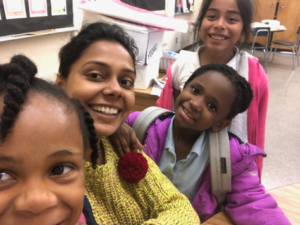 Wonderkids’ Cancer Themed Curriculum Spring 2019
Wonderkids’ Cancer Themed Curriculum Spring 2019
Originally Published February 20, 2018
This Spring 2019 semester, the Wonderkids Program was held as Foshay Learning Center and 32nd Street/USC Visual and Performing Arts Magnet and funded by a grant from the USC Norris Comprehensive Cancer Center (NCCC). Curriculum was written by Brittany Acevedo, Surbhi Bansil and Dieuwertje Kast. Students were able to explore more fields related to cancer, such as cardiology, dermatology, nanotechnology, and biomedical engineering.
The cardiology unit introduced students to the role of a cardiologist and their work with diagnosing and treating diseases of the heart and circulatory system. Students constructed paper models of the heart and circulatory system to visualize the parts of the body cardiologists are focused on. Students then took a closer look at blood–the central component of the circulatory system. Students created their own models of blood, including its major constituents (i.e. plasma, white blood cells, red blood cells, and platelets). The concept of blood cell based cancers was introduced. Students finished off the unit by creating a heart pumping model that mimics the pressure-based flow of blood throughout different chambers of the heart and used the blood pressure cuffs, stethoscopes, and the scientific method to determine how varying levels of exertion affect their blood pressures and heart rates.
With the dermatology unit, students were introduced to the role of a dermatologist and were taught the basic structural anatomy of the integumentary system. Some of the experiments included creating their own ‘Skin Models’ with emulative sponges, styrofoam, and other everyday craft supplies and learning more about the treatment of injuries by taking on the role of a physician with a paper, straw, and yarn model suture repair activity. The remaining two lessons adapted elements of the World Health Organization and Cancer Council Victoria’s SunSmart program’s in order to provide students preventional education and awareness of skin cancer causes and pathologies. For example, students were familiarized with the effects of UV radiation as a leading cause of skin cancer through a UV bead experiment, and were introduced to skin cancer and dermatologist’s role in recognizing and diagnosing skin cancer using ‘The ABCDEs of Melanoma.’

The nanotechnology unit provided students the opportunity to explore their world through the lens of a nanotechnologist. For example, in the first lesson students used a nanometer ruler to measure various everyday objects and compare the nanoscale to the metric scale as they converted centimeters to nanometers. Nanotechnology is now frequently the base of new cancer drugs. Students further explored how to use water-repellent nanoparticles that contain iron to investigate a new way to clean up oil spills. Students were also provided the opportunity to manipulate polymers to create Insta Worms, and observed how materials behave differently as their surface area increases.
In the final unit, biomedical engineering, students were introduced to the role of biomedical engineers and explored a plethora of medical technology designed to assist people with medical disadvantages. Students were introduced to the ultrasound imaging process and took on the role of a sonographer to make a diagnosis about their own patient, and locate a tumor. For the remainder of the unit students put into practice the engineering design process to create prototypes of a hearing trumpet, pollution mask, and prosthetic leg. Students worked collaboratively to generate and compare multiple possible solutions to a problem, based on how well each was likely to meet the criteria and constraints of the problem. To increase inclusivity, American Girl dolls were fitted with 3D printed arm and leg prosthetics. The dolls were donated by Kitty Guo and the 3D printed components were created by Deezmaker.

Emma Dessau, the coordinator for Foshay, says “WonderKids has been an immense blessing to bring to Foshay students! Every time the kids see me at site, they run up to me and ask, “is there science today? One of the most popular lessons this semester involved using stethoscopes to listen to their hearts and learn about their different paces during our cardiology unit!”
Sabrina Barrow, coordinator at 32nd St. says “Wonderkids has always been my favorite part of the after-school program. The kids get exposure to interesting science topics such as dermatology, cardiology, nanotechnology, and biomedical engineering. From making their own model of the heart to getting to listen to skilled scientists and doctors, this program is a unique learning experience.”
List of Speakers

(Photo of Dr. Amy Porter with Wonderkids Program students)
Additionally, one lesson in each unit was presented by guest speakers to share more about their work, to engage children in fun and exciting science activities, and to answer any lingering questions children may have. Dr. Amy Porter, Anupam Singh, Brittany Acevedo, Surbhi Bansil, Rita Barakat and students from the Associated Students of Biomedical Engineering (ASBME) Club are a few guest speakers who shared their content knowledge and research with the students this past spring.